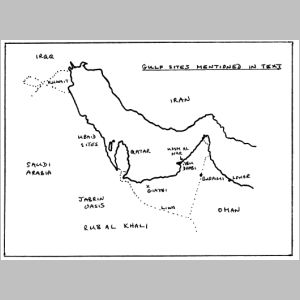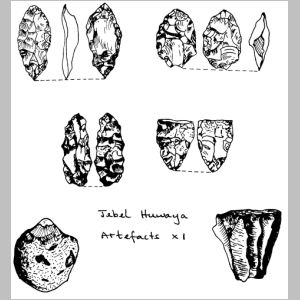Bulletin 6 - December 1978: Evidence for the Prehistoric Use of Flint in the Western Gulf
Evidence for the Prehistoric Use of Flint in the Western Gulf
with special reference to Abu Dhabi
IntroductionThe major problem in trying to assess the prehistoric period in Eastern Saudi and the Lower Gulf is the lack of stratified sites. Most of the hard and fast evidence for the Paleolithic elsewhere has come from rock shelters and caves, where archaeologists have been able to sift through successive layers of human debris. The Haua Fteah cave in Eastern Libya, for example, has yielded artifacts in an uninterrupted sequence dating back to c 60,000 BP and the famous cave at Shanidar, in Iraq, to c 50,000 BP. Virtually all pre-historic and pre-pottery sites on the Arabian side of the Gulf are on the present ground surface or beneath dunes, and often contain an apparent mixture of flint types.
The SitesIt is only in the last 15 years or so that any scientific investigation has taken place in this area. In the mid-Sixties, Danish expeditions worked in Bahrain and Qatar, and took in flying visits further up and down the coast, including Abu Dhabi. The area most researched for flint has been Qatar, where some 300 surface sites of prehistoric date have been found. Of these, 131 were characterized as Stone Age sites. These sites have been subject to attack by the predominant north wind - the Shamal - and by dune action for millennia so that now they are all exposed. There is at least one reliable radiocarbon date from flint-associated material in Qatar, at around 3,600 BC. However, there is none of the quality of evidence of techniques attributed to the Mesolithic or Neolithic in other parts of the world, and hence this and similar sites are tentatively placed in the "post-Paleolithic".
In Saudi Arabia, small hand axes have been found over the past few years on low mounds in the region of Yabrin oasis that is now only seasonally occupied. The inference is that the oasis in prehistoric times must have been better able to support a hunting, albeit nomadic, economy. Interestingly, tabular flint tools are common in Saudi, whereas to date only nodular flint artifacts have been found in the UAE.
Most recent work in Eastern Saudi has concentrated on Ubaid sites, early examples of which contain vast numbers of worked flints. Only recently was it realized that Mesopotamian Ubaid cultures extended so far down the Gulf, some of them over 50 km from the present coastline.
There is evidence that the Rub'al Khali, or Empty Quarter, must have supported Paleolithic populations. Many amateurs have turned up worked flints among the dunes, and a few fine arrowheads were found very recently at Giathi, inside the UAE. On typological grounds, these flints are undoubtedly linked to the Qatar series, and display definite signs of the post-Paleolithic. One or two of them are finely pressure-flaked, some of them have (broken) tangs, and all are very thin in section.
In spite of extensive field research, there are virtually no examples of worked flint from Umm an Nar. It is likely that the local heavily eroded and pitted tabular flint was unsuitable for flaking.
The most important recent discovery in the Abu Dhabi region has been in the foothills beyond Al Ain and close to the wadi at Al Ain itself. This wadi has turned up a couple of arrowheads and several pieces of worked flint. By far the prolific site, however, is the Jebel Huwayyah area. Once a vast anticline, this Jebel is open to the north and gradually rises towards the back rim at the southern end. The whole area is a vast mass of shattered flint nodules, but the chief concentrations of worked material are on the tops of the limestone slopes of the western and eastern arms of Jebel Huwayyah itself.
InterpretationIt would appear from the vast amount of broken nodules surrounded by waste flakes and some implements that this represents a factory site, that is, a flint source where the material was broken on the spot, roughly chipped and the best pieces then taken to an as yet unidentified place (or places) for final trimming. This spot might have been a temporary campsite.
Most of the implements found fall into two main categories. The first consists of oval or "willow leaf" shapes, up to 10 cm long by 5 cm wide with a fairly flat or biconvex section. The second consists of thinner and shorter pieces, with rougher, thicker sections. One tanged arrowhead and one tiny barbed arrow head have been found so far and four examples of good pressure flaking. A few of the artifacts have a mauve tint, which is characteristic of heat treatment, although this may have been accidental.
In view of the general crudity of the artifacts, it seems that there are two possibilities as to their function. They may be discarded scrapers or burins, though this is unlikely since most of them are manufactured from good-quality flint and are large enough to leave scope for further trimming; or they may be tools in themselves used for pressure flaking other flint implements. There are one or two apparently intrusive pieces of various dark red and blue colors. On all of the worked pieces, the flaked edges are quite distinct, and the patina on the deep toffee-colored flint is very thin. Thus it would seem that none are very old.
Compared with other Eastern Arabian sites, Jebel Huwayyah lacks some characteristic types, particularly tanged arrowheads and more evidence of pressure flaking. The types that do exist can be commonly found on sites ranging from Qatar to Sohar in Oman. The most closely associated sites, typologically, seem to be further down in Oman towards Dhofar. Since nearly all the sties are surface finds, it is impossible to say if a collection represents one industry or several over a long period of time. However, pressure flaking is known to have become fairly standardized in Eastern Arabia in the 4th millennium BC and its inclusion at Jebel Huwayyah could suggest a time roughly corresponding to the Qatar radiocarbon date.
Besides the implements themselves, a few good blade cores have been found, though not a single corresponding blade. One good hammer stone and a few possibles have also turned up.
There is little doubt that in the past the climate of Eastern Arabia has at times been kinder. A traditional comparison is that the European interglacial sequences were matched further south by pluvial, or cool, rainy periods. There is evidence that Arabia was, at one stage at least, affected by plate tectonics; its eastern coast was tipped down eastwards, permitting a marine transgression into low-lying parts of the Rub'al Khali. As the tilting gradually stabilized at the end of the last interglacial, drainage progressed to where the UAE landscape might have resembled the marshes of Southern Iraq. Aridity in the area seems to have set in in earnest around 4,500 BC at which point in time radiocarbon dating records the beginning of subkha formation. The edges of several ancient inland lakes are marked by marine shells. Flint remains the primary cultural association, however, very occasionally being found in the presence of cairns (not necessarily contemporary) in Qatar and Jebel Huwayyah.
Hence there is no doubt that Stone Age man lived and died in Abu Dhabi emirate. It is certain that a great deal of his flint handiwork must be buried under alluvium and the dunes. The contours of the littoral are constantly changing, and it would appear that the sea is still retreating (or the coast rising) as the present position of the Umm an Nar site, once right on the sea's edge, amply testifies.
Arabia lies directly between East Africa and Southwest Asia, where Lower Paleolithic tools have been found in abundance. Yet in this area the contexts are described as post-Paleolithic, very close to historical times. It would seem reasonable to suggest that man at some point could have crossed the Bab el Mandab Straits from Africa into Yemen. Even if he didn't, he had scores of millennia in which to explore Arabia from the north. Possibly the answer is to be found further inland, in the Rub'al Khali. It seems very logical to assume that the interior of Abu Dhabi emirate is likely in future to reveal further evidence to show that man lived here before the "post-Paleolithic".
Bibliography- A. General
- Bruce-Mitford, R.L.S. (1967). Flint Implements. Brit. Mus.
- Coles, J.M. and Higgs, E.S. (1969). The Archaeology of Early Man. Faber, London
- Clark, G. and Piggoff, S. (1965). Prehistoric Societies. Hutchinson.
- Oakley, K.P. (1972). Man the Tool Maker. Brit. Mus.
- Shepherd, W. (1972). Flint. Faber, London.
- Coles, J.M. and Higgs, E.S. (1969). The Archaeology of Early Man. Faber, London
- B. Locally Related
- Bergne, P. and Copeland, L. (1976). Flint Artifacts from the Buraimi Area.
(Proc. Seminar for Arabian Studies, 6, 40 - 61)
- Bibby, G. (1970). Looking for Dilmun. Collins.
- Burkholder, G. (1972). Ubaid Sites and Pottery in Southern Arabia. Archaeology 25, 4, 264 - 269.
- De Cardi, B. (1974). The British Archaeological Expedition to Qatar, 1973 - 74. Antiquity XLVIII, 196 - 200.
- Golding, M. (1974). Evidence for the preselencid Occupation of Eastern Arabia. (Proc. Seminar for Arabian Studies, 4, 19 - 48)
- Masry, A. (1974). Pre-history in Northeastern Arabia. Field Research Project Publications, Miami.
- Oates, J. (1976). Prehistory in Northeastern Arabia. Antiquity L, 20 - 27
- Bibby, G. (1970). Looking for Dilmun. Collins.

